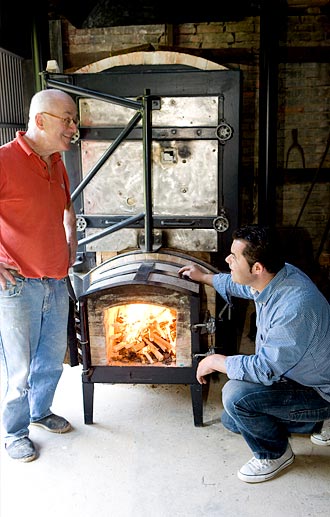
2008
This is a seminal year: after a thirty-year absence
on Chemin de Larreguy, Cazaux re-introduce the
great wood fired kiln. In addition, they create
the iconic ‘Flying Fish’ design, together with new
black enamel pieces, and others using a variety of
oxides - including gold and platinum.
The first Cazaux wall sculpture is produced
featuring a gold flying fish: artistic innovation
and long held traditions fuse together as Jean-Marie
passes the baton to Joel!
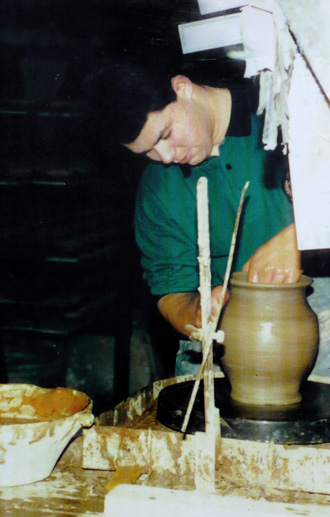
1985
In 1985 Joel is just fifteen years old ; he begins
his apprenticeship at his father’s side and a newly
minted era of Cazaux creativity has commenced :
the sixth generation looks to the future as a
fascinating period of familial collaboration is forged.
Overtime, responsibilities in the workshop are
shared and new challenges jointly faced.
With an exceptional artistic sense, Joel develops
new designs, shapes and creations while respecting
the company’s great tradition and inimitable Cazaux spirit !
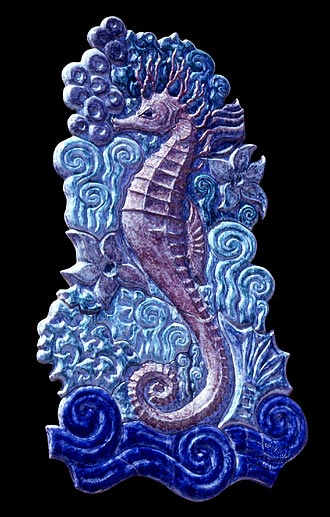
1975
After the same tradition of his father and uncles’
Sea Fountain at the Biarritz Sea Museum, in 1975
Jean-Marie designs and builds a magnificent
Seahorse for Ibarritz Sea Spa... by now Joel
is already going to the atelier to watch his
father working.
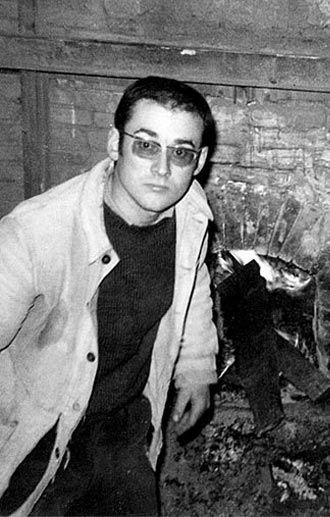
1968
As Jean-Marie matures he begins to develop an
acute sense of form and a discerning eye for
creating pottery and ceramics under the caring
`
supervision of his uncle Edouard, who sees
Jean-Marie as his true successor. In every letter
to Armand, Edouard enquires about his son’s
progress... in 1961, “I hear Jean-Marie is
the champion”, or, in a 1965 letter to Jean-Marie;
“Bravo Jean-Marie - he who seeks shall find...
walk straight ahead and all Cazaux living
or dead will follow you!” Edouard continues sending
Jean-Marie technical advice and recommendations
and the Cazaux chain continues!
Jean-Marie seen in front of the large wood fired
Cazaux kiln in the Chemin de Larreguy workshop.
In 1970, Jean-Marie ands his wife Josette have
a son, Joel.
Having mastered his art, Jean-Marie continues to
exchange letters with his beloved uncle Edouard up
until his death in 1974.
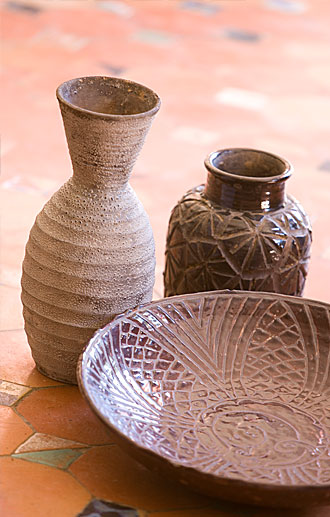
1950
In the 1950’s Armand adopts a new series of motifs
for his work; incorporating deer and women as the
principal themes... these designs echo primitive
cave paintings.
This stunning work is enhanced by the flames and
smoke within the Cazaux wood fired kiln,
and during this same period Armand fires large
reddish-brown plates, pieces which eloquently
symbolize a bold era of Cazaux creativity.
In 1952, Edouard writes to his brother Armand;
“be quite sure to watch Jean-Marie grow... he will
be better than us. In times to come, when people
speak about Cazaux, they will say only that
we were three!”
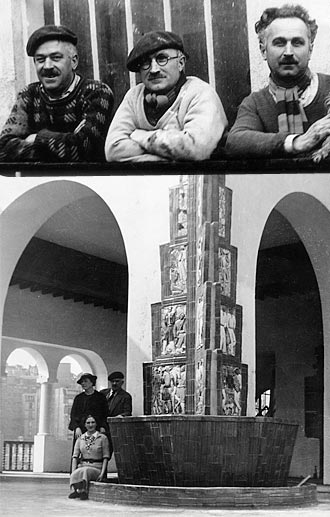
1937
Together, Edouard, Vincent and Armand create
the ‘3 B’ fountain, for the Basque pavillion
within the 1937 Paris International Exhibition.
In addition, they design a great ceramic murale,
the mould for which remains in the Chemin de
Larreguy workshops to this day. As a result of
this combined effort, the brothers receive
the exhibition’s prestigious Gold Medal and
Edouard begins building a successful reputation
in Paris.
While meeting many other artists, Edouard remains
in touch with his Basque based brothers, Vincent
and Armand. He regularly sends letters detailing
ideas and sharing information gleaned from his
own artisanal circle.
Soon Vincent is named ‘Best French Craftsman’
while Armand continues with his interior decoration
at Chateau de Brindos in Biarritz. In 1942,
a son Jean-Marie is born.
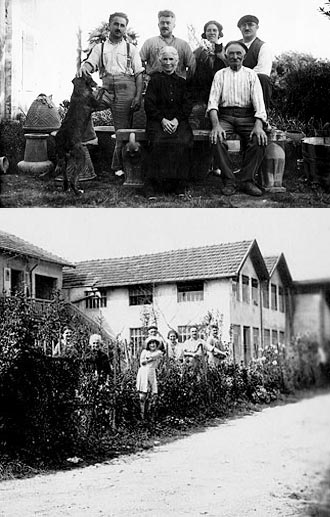
1928
The 1914-18 war was a difficult period for the aging
Alcide and Valerie, all three of their sons served in
the army and when Armand returns from seving
his country, their faltering business is saved by
a large order of resin pots. In 1920 Edouard returns
to Paris for good, settling in La Varenne St Hilaire.
Armand arrives to help his brother establish
production of artistic ceramics. Having accumulated
great experience, Armand returns to the Negresse
workshop in 1922 and resumes working with his
father and older brother Vincent.
The three Cazaux brothers maintain contact
through weekly correspndence, exchanging
drawings, techniques, recipes and discoveries.
Production is gradually changing with more
emphasis on decorative pieces, both indoor
and outdoor. In 1921 the first order is placed
for interior decoration, this is the beginning
of Cazaux tilework.
In 1928, as demand for Cazaux ceramics
increases, an enlarged workshop is built –
this is the same Negresse atelier we see today.
Moving into the 1930’s, with the construction
of many beautiful villas and houses on
the Basque coastline, Cazaux expand their
repertoire and evelove a totally original style.
Armand and Vincent still receive Parisian
contributions from Edouard and their ceramics
range expands to encompass furniture.
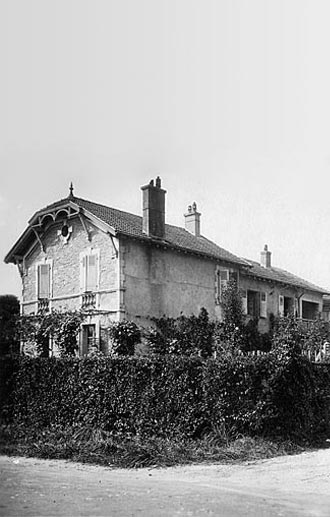
1908
In 1908 Alcide and Valerie’s dream comes true;
having acquired a piece of land at Chemin de
Larreguy, they build their own house and workshop.
It is here their three sons Edouard, Vincent and
Armand grow up.
The pottery becomes more elaborate and
sophisticated after young Edouard serves
an apprenticeship in Oustau, from where
he returns with a few potter’s ‘secrets’,
before departing for Paris at the age of 18.
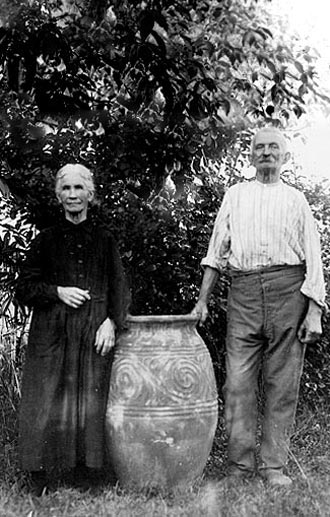
1893
The Cazaux story began in the 19th century,
when a group of modest potters, from Cagnotte
in the Landes region of South-west France evolved
a cottage industry, producing earthenware jugs and
plates for their wives to sell in local village markets.
Amongst their number were Jean-Baptiste and
Marie Cazaux, whose son Alcide, born in 1857,
became well known in the region for his ‘Pegas’
or large water jugs their extreme delicacy of design
and lightness.
Alcide married Valerie who gave birth to a son,
Edouard. The family moved across the Adour river
to Bayonne, where a second son Vincent was born
and in 1893 the young family move to the Negresse
quarter of nearby Biarritz, where a third son
Armand was born in 1895.
Alcide continues to create his famous ‘Pegas’ made
with local earth from the villages of Arcangue
and Espelette. Working a great deal with local
house builders the couple dream of building a home
and workshop of their own.
Cazaux in Biarritz
A ceramacist’s story spanning seven generations: beginning
in the humble Landes village of Cagnotte during the early part of
the 19th century and moving to the aristocratic resort of Biarritz
in 1890; Cazaux metamorphosed from everyday pottery to beautiful
and refined decorative art.
Throughout the prosperous 1930’s, grand villas and stately
mansions proliferated along the Atlantic coast; as bourgeois
prosperity grew, Cazaux’s definitive identity evolved.
In a land beloved by Chanel, Matisse and Dior, a unique style
developed, combining audacious use of form and limitless
creativity. Since this golden Basque age, Cazaux’s rigorous
application, attention to detail and imaginative use of colour,
has excited modern collectors and international connoisseurs alike.
By utilising oxides, platinum and gold, together with humble fired
earth, Cazaux imaginitively unites opulence with authentic
artisanal skills.
